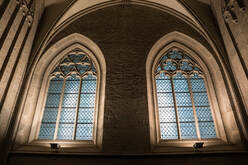|
Although the Word of God comes to us supremely through faithful preaching and teaching, the Word also comes through symbolic means, like songs, music, art, architecture, poetry, public prayer, acts of service, liturgy, and the sacraments of baptism and the Lord’s Supper. People aren’t only ears sitting in pews; we’re also eyes that see, hands that touch, and hearts that feel. People need to see the gospel as well as hear the gospel. In contemporary Christianity, one of the most commonly overlooked ways of seeing the Word is architecture. Symbolizing and reflecting the truth, beauty, and goodness of God is one of the key benefits of intentional architectural design. Medieval Christians, many of whom were illiterate, relied on “theology in stone” to present the Word through art and architecture of basilicas and gothic cathedrals. The awe and grandeur of God are still plainly evident when you walk into one of the great cathedrals of Europe or their Gothic Revival replicas in North America. The stained glass windows, paintings, and sculptures tell tales from the Bible and church history, as well as convey moral and biblical lessons to viewers. The acoustics, grandness, and lighting create feelings of wonder for God and a keen awareness of the smallness of humanity. Author Doug Jones remarks that “architecture entices humility.” With thick walls and narrow, coloured windows that filter and mute natural light, traditional church architecture also symbolizes both separation from the outside world and a sense of the sacred.
Someone might argue that we don’t need church buildings. True. We also don’t “need” books, blogs, church picnics, seminaries, systematic theology, tracts, pianos, projectors, pews, or pulpits… but they are helpful, and the Lord uses these valuable (though unnecessary) tools to accomplish his purposes. Someone may also be concerned that aesthetically evoked emotions will serve as a substitute for an authentic relationship with God. Sadly, in some cases, this may be true. But a hammer can be a tool as well as a bludgeoning weapon. The problem isn’t necessarily with the tool but the user. To illustrate the point, let’s take a look at another form of art that is more readily appreciated by modern Christians. Church music and hymns are a big part of Protestant worship, speaking more to our hearts and bodies than to our heads. Good theology matters in our hymnody, but the value of hymns goes beyond conveying doctrine in the lyrics. If we only wanted to transmit theology, then we wouldn’t use lyrical poetry and stirring tunes to do the job. Reading excerpts from Calvin’s Institutes would be more to the point. Yet, we choose to sing hymns, in part, because it moves our hearts. We feel music in our physical bodies as we sing and listen. Like music, architecture speaks to our “incarnated” souls. It is no wonder that Goethe describes architecture as “frozen music;” architecture helps us to feel as well as know the gospel. We need to ask ourselves, what impressions are we giving to visitors who come to our places of worship? What messages are we sending to our congregations? Indeed, we are often limited by funding or by our situations. Some congregations rent spaces that have multiple uses, like schools, civic centres, and libraries. Architectural considerations may be off the table for many. As a substitute, consider the placement of chairs, the appearance of the stage, lighting, drapery, flowers, and artwork, and whether you use a pulpit or music stand. Do what you can to convey truth, beauty, and goodness with your surroundings, inspiring both love and wonder for the things of God. He is worthy of our efforts! Part 3 of a three part series on architecture This essay originally appeared in Barnabas, Vol. 12, No.3 (Summer 2020): 6 This is Part 3 of a three part series on Christianity and architecture. Click here for Part 1 "The Art of Architecture" and here for Part 2 "Architectural Gnostocism."
0 Comments
|
Jeremy W. JohnstonChristian, husband, father, teacher, writer. Archives
June 2024
CategoriesAll ANNE BRADSTREET CHRISTMAS COVID 19 CS LEWIS DOUBT EASTER Family Worship FRANCIS SCHAEFFER GUEST BLOG POST JRR TOLKIEN MENTORING MONK'S GUIDE ON ARCHITECTURE ON DEATH ON EXCELLENCE ON HISTORY ON MUSIC ON OLD BOOKS ON POETRY ON THE ARTS ON WRITING PODCAST POETRY PRAYER THANKSGIVING TOLKIEN |



 RSS Feed
RSS Feed
